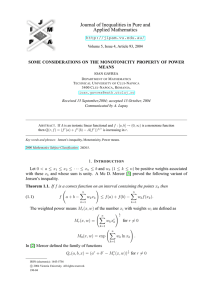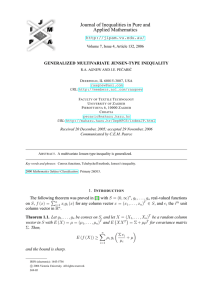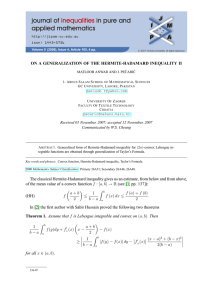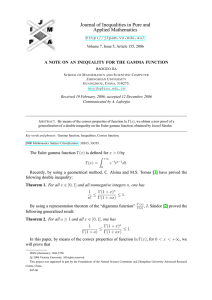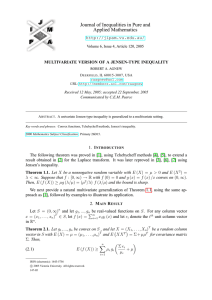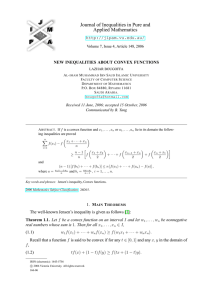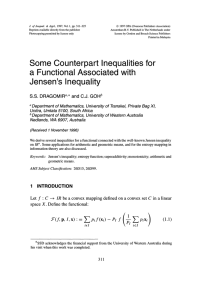ON CERTAIN INEQUALITIES IMPROVING THE HERMITE-HADAMARD INEQUALITY Communicated by S.S. Dragomir
advertisement
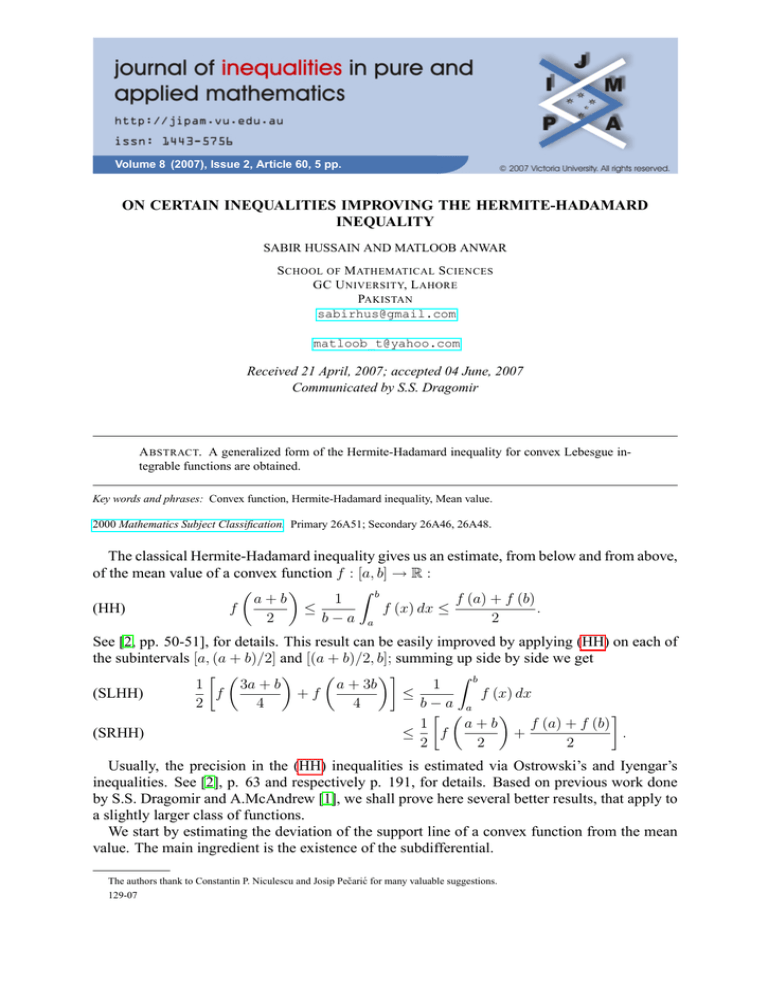
Volume 8 (2007), Issue 2, Article 60, 5 pp. ON CERTAIN INEQUALITIES IMPROVING THE HERMITE-HADAMARD INEQUALITY SABIR HUSSAIN AND MATLOOB ANWAR S CHOOL OF M ATHEMATICAL S CIENCES GC U NIVERSITY, L AHORE PAKISTAN sabirhus@gmail.com matloob_t@yahoo.com Received 21 April, 2007; accepted 04 June, 2007 Communicated by S.S. Dragomir A BSTRACT. A generalized form of the Hermite-Hadamard inequality for convex Lebesgue integrable functions are obtained. Key words and phrases: Convex function, Hermite-Hadamard inequality, Mean value. 2000 Mathematics Subject Classification. Primary 26A51; Secondary 26A46, 26A48. The classical Hermite-Hadamard inequality gives us an estimate, from below and from above, of the mean value of a convex function f : [a, b] → R : Z b a+b 1 f (a) + f (b) (HH) f ≤ f (x) dx ≤ . 2 b−a a 2 See [2, pp. 50-51], for details. This result can be easily improved by applying (HH) on each of the subintervals [a, (a + b)/2] and [(a + b)/2, b]; summing up side by side we get Z b 1 3a + b a + 3b 1 (SLHH) f +f ≤ f (x) dx 2 4 4 b−a a 1 a+b f (a) + f (b) (SRHH) ≤ f + . 2 2 2 Usually, the precision in the (HH) inequalities is estimated via Ostrowski’s and Iyengar’s inequalities. See [2], p. 63 and respectively p. 191, for details. Based on previous work done by S.S. Dragomir and A.McAndrew [1], we shall prove here several better results, that apply to a slightly larger class of functions. We start by estimating the deviation of the support line of a convex function from the mean value. The main ingredient is the existence of the subdifferential. The authors thank to Constantin P. Niculescu and Josip Pečarić for many valuable suggestions. 129-07 2 S ABIR H USSAIN AND M ATLOOB A NWAR Theorem 1. Assume that f is Lebesgue integrable and convex on (a, b). Then Z b 1 a+b f (y)dy + ϕ(x) x − − f (x) b−a a 2 Z b 2 2 1 (x − a) + (b − x) ≥ |f (y) − f (x)| dy − |ϕ(x)| b−a 2(b − a) a for all x ∈ (a, b). Here ϕ : (a, b) → R is any function such that ϕ(x) ∈ [f−0 (x), f+0 (x)] for all x ∈ (a, b). Proof. In fact, f (y) ≥ f (x) + (y − x)ϕ(x) for all x, y ∈ (a, b), which yields (Sd) f (y) − f (x) − (y − x)ϕ(x) = |f (y) − f (x) − (y − x)ϕ(x)| ≥ ||f (y) − f (x)| − |y − x| |ϕ(x)|| . By integrating side by side we get Z b a+b f (y)dy − (b − a)f (x) + (b − a) x − ϕ(x) 2 a Z b ≥ ||f (y) − f (x)| − |y − x| |ϕ(x)|| dy a Z b Z b ≥ |f (y) − f (x)| dy − |ϕ(x)| |y − x| dy a a Z b 2 2 (x − a) + (b − x) = |f (y) − f (x)| dy − |ϕ(x)| 2 a and it remains to simplify both sides by b − a. Theorem 1 applies for example to convex functions not necessarily defined on compact in−α tervals, for example, to f (x) = (1 − x2 ) , x ∈ (−1, 1), for α ≥ 0. Theorem 2. Assume that f : [a, b] → R is a convex function. Then Z b 1 f (b)(b − x) + f (a)(x − a) 1 f (x) + − f (y)dy 2 b−a b−a a Z b Z b 1 1 1 0 ≥ |f (x) − f (y)| dy − |x − y| |f (y)| dy 2 b−a a b−a a for all x ∈ (a, b). Proof. Without loss of generality we may assume that f is also continuous. See [2, p. 22] (where it is proved that f admits finite limits at the endpoints). In this case f is absolutely continuous and thus it can be recovered from its derivative. The function f is differentiable except for countably many points, and letting E denote this exceptional set, we have f (x) ≥ f (y) + (x − y)f 0 (y) for all x ∈ [a, b] and all y ∈ [a, b]\E.This yields f (x) − f (y) − (x − y)f 0 (y) = |f (x) − f (y) − (x − y)f 0 (y)| ≥ ||f (x) − f (y)| − |x − y| · |f 0 (y)|| , J. Inequal. Pure and Appl. Math., 8(2) (2007), Art. 60, 5 pp. http://jipam.vu.edu.au/ I MPROVING THE H ERMITE -H ADAMARD I NEQUALITY 3 so that by integrating side by side with respect to y we get Z b (b − a)f (x) − 2 f (y)dy + f (b)(b − x) + f (a)(x − a) a Z b Z b 0 ≥ |f (x) − f (y)| dy − |x − y| |f (y)| dy a a equivalently, Z b f (b)(b − x) + f (a)(x − a) 2 f (x) + − f (y)dy b−a b−a a Z Z b 1 b 0 ≥ |f (x) − f (y)| dy − |x − y| |f (y)| dy b−a a a and the result follows. A variant of Theorem 2, in the case where f is convex only on (a, b), is as follows: Theorem 3. Assume that f : [a, b] → R is monotone on [a, b] and convex on (a, b). Then Z b 1 (x − a)f (a) + (b − x)f (b) 1 f (x) + − f (y)dy 2 b−a b−a a Z b 1 sgn(x − y)f (y)dy ≥ b−a a 1 + [f (x)(a + b − 2x) + (x − a)f (a) + (b − x)f (b)] 2(b − a) for all x ∈ (a, b). Proof. Consider for example the case where f is nondecreasing on [a, b]. Then Z b Z x Z b |f (x) − f (y)| dy = |f (x) − f (y)| dy + |f (x) − f (y)| dy a a x Z x Z b = (x − a)f (x) − f (y)dy + f (y)dy − (b − x)f (x) a x Z x Z b = (2x − a − b)f (x) − f (y)dy + f (y)dy. a x As in the proof of Theorem 2, we may restrict ourselves to the case where f is absolutely continuous, which yields Z b Z x Z b 0 0 |x − y| |f (y)| dy = (x − y)f (y)dy + (y − x)f 0 (y)dy a a x Z x Z b = (a − x)f (a) + (b − x)f (b) + f (y)dy − f (y)dy. a x By Theorem 2, we conclude that Z b 1 f (b)(b − y) + f (a)(y − a) 1 f (y) + − f (x)dx 2 b−a b−a a J. Inequal. Pure and Appl. Math., 8(2) (2007), Art. 60, 5 pp. http://jipam.vu.edu.au/ 4 S ABIR H USSAIN AND M ATLOOB A NWAR Z b Z x 1 2 ≥ f (y)dy − f (y)dy 2 b−a x a f (x)(2x − a − b) (x − a)f (a) + (b − x)f (b) + − . b−a b−a The case where f is nonincreasing can be treated in a similar way. For x = (a + b)/2, Theorem 3 gives us Z b 1 a+b f (a) + f (b) 1 (UE) f + − f (y)dy 2 2 2 b−a a Z b 1 a + b f (a) + f (b) , ≥ sgn − y f (y)dy + b−a 2 4 a which in the case of the exponential function means a + b exp a + exp b 1 exp b − exp a exp + − 2 2 2 b−a Z b 1 a + b exp a + exp b ≥ sgn − y exp y dy + b−a a 2 4 for all a, b ∈ R, a < b, equivalently, 1 √ 2 √ b−a a+b a + b a + b − 2 ab − ≥ − ab + 2 ln b − ln a 4 ln b − ln a for all 0 < a < b. This represents an improvement on Polya’s inequality, (Po) 2 √ 1 a+b b−a · ab + · > 3 3 2 ln b − ln a since √ 2 √ 1 a+b 1√ a + b − 2 ab · ab + · > . ab + 3 3 2 2 ln b − ln a In fact, the last inequality can be restated as (x + 1)2 ln x > 3 (x − 1)2 for all x > 1, a fact that can be easily checked using calculus. As Professor Niculescu has informed us, we can embed Polya’s inequality into a long sequence of interpolating inequalities involving the geometric, the arithmetic, the logarithmic and J. Inequal. Pure and Appl. Math., 8(2) (2007), Art. 60, 5 pp. http://jipam.vu.edu.au/ I MPROVING THE H ERMITE -H ADAMARD I NEQUALITY 5 the identric means: √ √ 2/3 a + b 1/3 ab < ab 2 1/(b−a) b−a 1 bb < < ln b − ln a e aa 2 √ 1 a+b < · ab + · 3 3 2 r √ a+b ab < 2 a+b 1 a+b √ < + ab < 2 2 2 for all 0 < a < b. Remark 4. The extension of Theorems 1 – 3 above to the context of weighted measures is straightforward and we shall omit the details. However, the problem of estimating the HermiteHadamard inequality in the case of several variables is left open. R EFERENCES [1] S.S. DRAGOMIR AND A. MCANDREW, Refinements of the Hermite-Hadamard inequality for convex functions, J. Inequal. Pure and Appl. Math., 6(5) (2005), Art. 140. [ONLINE: http:// jipam.vu.edu.au/article.php?sid=614]. [2] C.P. NICULESCU AND L.-E. PERSSON, Convex Functions and Their Applications. A Contemporary Approach, CMS Books in Mathematics, Vol. 23, Springer-Verlag, New York, 2006. [3] J.E. PEČARIĆ, F. PROSCHAN AND Y.C. TONG, Convex functions, Partial Orderings and Statistical Applications, Academic Press, New York, 1992. J. Inequal. Pure and Appl. Math., 8(2) (2007), Art. 60, 5 pp. http://jipam.vu.edu.au/
